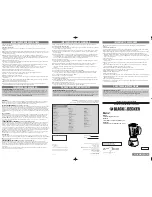
724-746-5500 | blackbox.com
Page 87
Console and Telnet Configuration
VLAN Tag Priority uses the tag field information which has been inserted into an Ether-
net frame. If a port has an 802.1Q-compliant device attached (such as this Ethernet
Extender), these tagged frames can carry VLAN membership information.
Priority defines the user priority level for different classes of traffic. There are 8 possi-
ble priority levels, with 0 being the lowest priority level and 7 being the highest level.
Each Priority level can be set queue from 0 to 3.
For example, you can set the LB52xA-KIT to use Weighted Round-Robin (WRR) queu-
ing (Type 1) that specifies a relative weight of each queue. WRR uses a predefined rel-
ative weight for each queue that determines the percentage of time to service for each
queue before moving on to the next queue.
IP DSCP Priority QoS
Differentiated Services (DiffServ) is a class of service (CoS) model that enhances
best-effort Internet services by differentiating traffic by users, service requirements and
other criteria. Packets are specifically marked, allowing network nodes to provide dif-
ferent levels of service, as appropriate for video playback, voice calls or other delay-
sensitive applications, via priority queuing or bandwidth allocation.
The DSCP value used to identify 64 levels (26=64) of service determines the forward-
ing behavior that each packet gets across the DiffServ network. Based on the marking
rule different kinds of traffic can be marked for different priorities of forwarding.
Table 25:
VLAN Tag Priority Levels
Priority Level
Traffic Type
0 (default)
Best Effort
1
Background
2
Spare
3
Excellent Effort
4
Controlled Load
5
Video, less than 100 milliseconds latency and jitter
6
Voice, less than 10 milliseconds latency and jitter
7
Network Control
Table 26:
VLAN Tag Priority QoS Options
VLAN Tag Index
0
1
2
3
4
5
6
7
Queue Index
















































